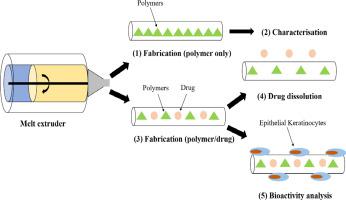Biomaterials Advances ( IF 5.5 ) Pub Date : 2020-11-04 , DOI: 10.1016/j.msec.2020.111696 Xiaoxuan Deng , Maree Gould , M. Azam Ali

|
Diclofenac potassium loaded sutures based upon PEG/PCL/chitosan-keratin blends were fabricated using the hot-melt extrusion technique. Polymer sutures were evaluated based on their physical, thermal and mechanical properties, while the drug-eluting sutures were evaluated for drug release properties. Lastly, the performance of the drug-loaded sutures in the contact with the human keratinocyte cell line HaCat were assessed. Results showed that the sutures extruded homogeneously at a temperature of 63 ± 1 °C providing a uniform thickness of fibres. Analysis by Differential Scanning Calorimetry (DSC) and Thermogravimetric Analysis (TGA) showed that completely amorphous and miscible solid dispersions were created. Fourier transform infrared (FTIR) spectroscopy indicated that the presence of hydrogen bonds between the polymers improved material miscibility. Tensile properties of the sutures were clearly affected by the PEG, chitosan and keratin additions. The optimal formulation of tensile strength was obtained when PCL/PEG/chitosan-keratin were combined at a ratio of 80/19/1 w/w. Rapid and sustained drug release rates were achieved with the PEG/PCL/chitosan/keratin blends at various combinations. The composite of PCL/PEG/chitosan-keratin with 30 wt% of diclofenac potassium also exhibited high cell viability and wound healing rates in vitro cytotoxicity testing. The anti-inflammatory properties imparted by the PCL/PEG/chitosan/keratin/drug sutures may further the use of composite sutures for wound healing in clinical settings.
中文翻译:

用于伤口愈合的熔融挤出壳聚糖/角蛋白/ PCL / PEG药物洗脱缝合线的制备和表征
使用热熔挤出技术制备了基于PEG / PCL /壳聚糖-角蛋白共混物的双氯芬酸钾负载缝合线。根据聚合物缝合线的物理,热和机械性能对其进行评估,而对药物洗脱缝合线的药物释放性能进行评估。最后,评估了载药缝线在与人角质形成细胞系HaCat接触中的性能。结果表明,缝线在63±1°C的温度下均匀挤出,提供了均匀的纤维厚度。通过差示扫描量热法(DSC)和热重分析(TGA)的分析表明,生成了完全无定形和可混溶的固体分散体。傅立叶变换红外(FTIR)光谱表明,聚合物之间氢键的存在改善了材料的混溶性。PEG,壳聚糖和角蛋白的添加明显影响了缝合线的拉伸性能。当PCL / PEG /壳聚糖-角蛋白的比例为80/19/1 w / w时,可获得最佳的拉伸强度。使用各种组合的PEG / PCL /壳聚糖/角蛋白混合物可以实现快速且持续的药物释放速率。PCL / PEG /壳聚糖-角蛋白与30%(双氯芬酸钾)的复合物在体外细胞毒性测试中也显示出高细胞活力和伤口愈合率。PCL / PEG /壳聚糖/角蛋白/药物缝合线赋予的抗炎特性可进一步将复合缝合线用于临床环境中的伤口愈合。PEG,壳聚糖和角蛋白的添加明显影响了缝合线的拉伸性能。当PCL / PEG /壳聚糖-角蛋白的比例为80/19/1 w / w时,可获得最佳的拉伸强度。使用各种组合的PEG / PCL /壳聚糖/角蛋白混合物可以实现快速且持续的药物释放速率。PCL / PEG /壳聚糖-角蛋白与30%(双氯芬酸钾)的复合物在体外细胞毒性测试中也显示出高细胞活力和伤口愈合率。PCL / PEG /壳聚糖/角蛋白/药物缝合线赋予的抗炎特性可进一步将复合缝合线用于临床环境中的伤口愈合。PEG,壳聚糖和角蛋白的添加明显影响了缝合线的拉伸性能。当PCL / PEG /壳聚糖-角蛋白的比例为80/19/1 w / w时,可获得最佳的拉伸强度。使用各种组合的PEG / PCL /壳聚糖/角蛋白混合物可以实现快速且持续的药物释放速率。PCL / PEG /壳聚糖-角蛋白与30%(双氯芬酸钾)的复合物在体外细胞毒性测试中也显示出高细胞活力和伤口愈合率。PCL / PEG /壳聚糖/角蛋白/药物缝合线赋予的抗炎特性可进一步将复合缝合线用于临床环境中的伤口愈合。当PCL / PEG /壳聚糖-角蛋白的比例为80/19/1 w / w时,可获得最佳的拉伸强度。使用各种组合的PEG / PCL /壳聚糖/角蛋白混合物可以实现快速且持续的药物释放速率。PCL / PEG /壳聚糖-角蛋白与30%(双氯芬酸钾)的复合物在体外细胞毒性测试中也显示出高细胞活力和伤口愈合率。PCL / PEG /壳聚糖/角蛋白/药物缝合线赋予的抗炎特性可进一步将复合缝合线用于临床环境中的伤口愈合。当PCL / PEG /壳聚糖-角蛋白的比例为80/19/1 w / w时,可获得最佳的拉伸强度。使用各种组合的PEG / PCL /壳聚糖/角蛋白混合物可以实现快速且持续的药物释放速率。PCL / PEG /壳聚糖-角蛋白与30%(双氯芬酸钾)的复合物在体外细胞毒性测试中也显示出高细胞活力和伤口愈合率。PCL / PEG /壳聚糖/角蛋白/药物缝合线赋予的抗炎特性可进一步将复合缝合线用于临床环境中的伤口愈合。PCL / PEG /壳聚糖-角蛋白与30%(双氯芬酸钾)的复合物在体外细胞毒性测试中也显示出高细胞活力和伤口愈合率。PCL / PEG /壳聚糖/角蛋白/药物缝合线赋予的抗炎特性可进一步将复合缝合线用于临床环境中的伤口愈合。PCL / PEG /壳聚糖-角蛋白与30%(双氯芬酸钾)的复合物在体外细胞毒性测试中也显示出高细胞活力和伤口愈合率。PCL / PEG /壳聚糖/角蛋白/药物缝合线赋予的抗炎特性可进一步将复合缝合线用于临床环境中的伤口愈合。











































 京公网安备 11010802027423号
京公网安备 11010802027423号